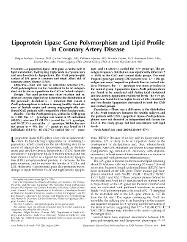| dc.contributor.author | Duman, Belgin Süsleyici | |
| dc.contributor.author | Türkoğlu, Caner | |
| dc.contributor.author | Akpinar, Belhhan | |
| dc.contributor.author | Güden, Mustafa | |
| dc.contributor.author | Vertii, Alexey | |
| dc.contributor.author | Dak, Esranur | |
| dc.contributor.author | Çağatay, Tülin | |
| dc.contributor.author | Günay, Demet | |
| dc.contributor.author | Buyukdevrim, Ahmet Sevim | |
| dc.date.accessioned | 2019-06-27T08:00:54Z | |
| dc.date.available | 2019-06-27T08:00:54Z | |
| dc.date.issued | 2004 | |
| dc.identifier.issn | 0003-9985 | en_US |
| dc.identifier.issn | 1543-2165 | en_US |
| dc.identifier.uri | https://hdl.handle.net/20.500.12469/151 | |
| dc.description.abstract | Context.-Lipoprotein lipase (LPL) plays a central role in lipid metabolism hydrolyzing triglyceride in chylomicrons and very-low-density lipoproteins. The PvuII polymorphic variant of LPL gene is common and might affect risk of coronary artery disease (CAD). Objective.-Our aim was to determine whether LPL-PvuII polymorphism can be considered to be an independent risk factor or a predictor for CAD in Turkish subjects. Design.-We used polymerase chain reaction and restriction enzyme digestion to determine the distribution of the previously described C-->T transition that causes a PvuII polymorphism in intron 6 among healthy blood donors of Turkish origin and among angiographically confirmed CAD patients with comparable ethnic backgrounds. Results.-For the PvuII genotypes within the CAD group (n = 80) the +/- genotype was found in 39 individuals (48.8%) whereas 25 (31.3%) carried the +/+ genotype and 14 (17.5%) carried the -/- genotype. Within the control group (n = 49) the -/- genotype was found in 19 individuals (38.8%) 16 (32.7%) carried the +/- genotype and 14 (28.6%) carried the +/+ genotype. The genotype frequency distribution was significantly different (P = .049) in the CAD and control study groups. The most frequent genotype among CAD patients was +/- | en_US] |
| dc.description.abstract | this genotype was more frequent in patients than in control subjects. However the -/- genotype was more prevalent in the control group. Lipoprotein lipase-PvuII polymorphism was found to be associated with fasting total cholesterol and low-density lipoprotein cholesterol levels. The +/+ genotype was found to have higher levels of total cholesterol and low-density lipoprotein cholesterol in both the CAD and control groups. Conclusion.-There was a difference in the distribution of LPL-PvuII genotypes between the healthy subjects and the patients with CAD. Lipoprotein lipase-PvuII polymorphisms were not detected as independent risk factors for CAD in this study group but had associations with lipid levels. | en_US] |
| dc.language.iso | eng | en_US |
| dc.publisher | COLL AMER PATHOLOGISTS | en_US |
| dc.rights | info:eu-repo/semantics/openAccess | en_US |
| dc.subject | N/A | en_US |
| dc.title | Lipoprotein lipase gene polymorphism and lipid profile in coronary artery disease | en_US |
| dc.type | article | en_US |
| dc.identifier.startpage | 869 | en_US |
| dc.identifier.endpage | 874 | |
| dc.relation.journal | Archives of Pathology & Laboratory Medicine | en_US |
| dc.identifier.issue | 8 | |
| dc.identifier.volume | 128 | en_US |
| dc.identifier.wos | WOS:000222998800007 | en_US |
| dc.identifier.scopus | 2-s2.0-3543013748 | en_US |
| dc.relation.publicationcategory | Makale - Uluslararası Hakemli Dergi - Kurum Öğretim Elemanı | en_US |
| dc.identifier.pmid | 15270617 | en_US |
















